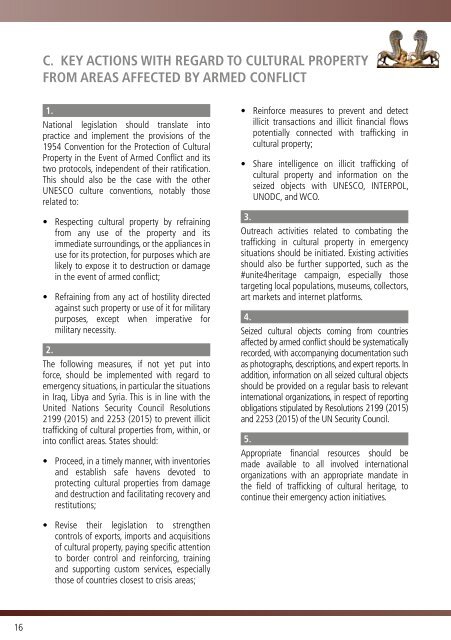CULTURAL HERITAGE
491_SRIUN_ProtectingCulturalHeritage_brochure_2016-09-12_LR
491_SRIUN_ProtectingCulturalHeritage_brochure_2016-09-12_LR
You also want an ePaper? Increase the reach of your titles
YUMPU automatically turns print PDFs into web optimized ePapers that Google loves.
C. KEY ACTIONS WITH REGARD TO <strong>CULTURAL</strong> PROPERTY<br />
FROM AREAS AFFECTED BY ARMED CONFLICT<br />
1.<br />
National legislation should translate into<br />
practice and implement the provisions of the<br />
1954 Convention for the Protection of Cultural<br />
Property in the Event of Armed Conflict and its<br />
two protocols, independent of their ratification.<br />
This should also be the case with the other<br />
UNESCO culture conventions, notably those<br />
related to:<br />
• Respecting cultural property by refraining<br />
from any use of the property and its<br />
immediate surroundings, or the appliances in<br />
use for its protection, for purposes which are<br />
likely to expose it to destruction or damage<br />
in the event of armed conflict;<br />
• Refraining from any act of hostility directed<br />
against such property or use of it for military<br />
purposes, except when imperative for<br />
military necessity.<br />
2.<br />
The following measures, if not yet put into<br />
force, should be implemented with regard to<br />
emergency situations, in particular the situations<br />
in Iraq, Libya and Syria. This is in line with the<br />
United Nations Security Council Resolutions<br />
2199 (2015) and 2253 (2015) to prevent illicit<br />
trafficking of cultural properties from, within, or<br />
into conflict areas. States should:<br />
• Proceed, in a timely manner, with inventories<br />
and establish safe havens devoted to<br />
protecting cultural properties from damage<br />
and destruction and facilitating recovery and<br />
restitutions;<br />
• Reinforce measures to prevent and detect<br />
illicit transactions and illicit financial flows<br />
potentially connected with trafficking in<br />
cultural property;<br />
• Share intelligence on illicit trafficking of<br />
cultural property and information on the<br />
seized objects with UNESCO, INTERPOL,<br />
UNODC, and WCO.<br />
3.<br />
Outreach activities related to combating the<br />
trafficking in cultural property in emergency<br />
situations should be initiated. Existing activities<br />
should also be further supported, such as the<br />
#unite4heritage campaign, especially those<br />
targeting local populations, museums, collectors,<br />
art markets and internet platforms.<br />
4.<br />
Seized cultural objects coming from countries<br />
affected by armed conflict should be systematically<br />
recorded, with accompanying documentation such<br />
as photographs, descriptions, and expert reports. In<br />
addition, information on all seized cultural objects<br />
should be provided on a regular basis to relevant<br />
international organizations, in respect of reporting<br />
obligations stipulated by Resolutions 2199 (2015)<br />
and 2253 (2015) of the UN Security Council.<br />
5.<br />
Appropriate financial resources should be<br />
made available to all involved international<br />
organizations with an appropriate mandate in<br />
the field of trafficking of cultural heritage, to<br />
continue their emergency action initiatives.<br />
• Revise their legislation to strengthen<br />
controls of exports, imports and acquisitions<br />
of cultural property, paying specific attention<br />
to border control and reinforcing, training<br />
and supporting custom services, especially<br />
those of countries closest to crisis areas;<br />
16


